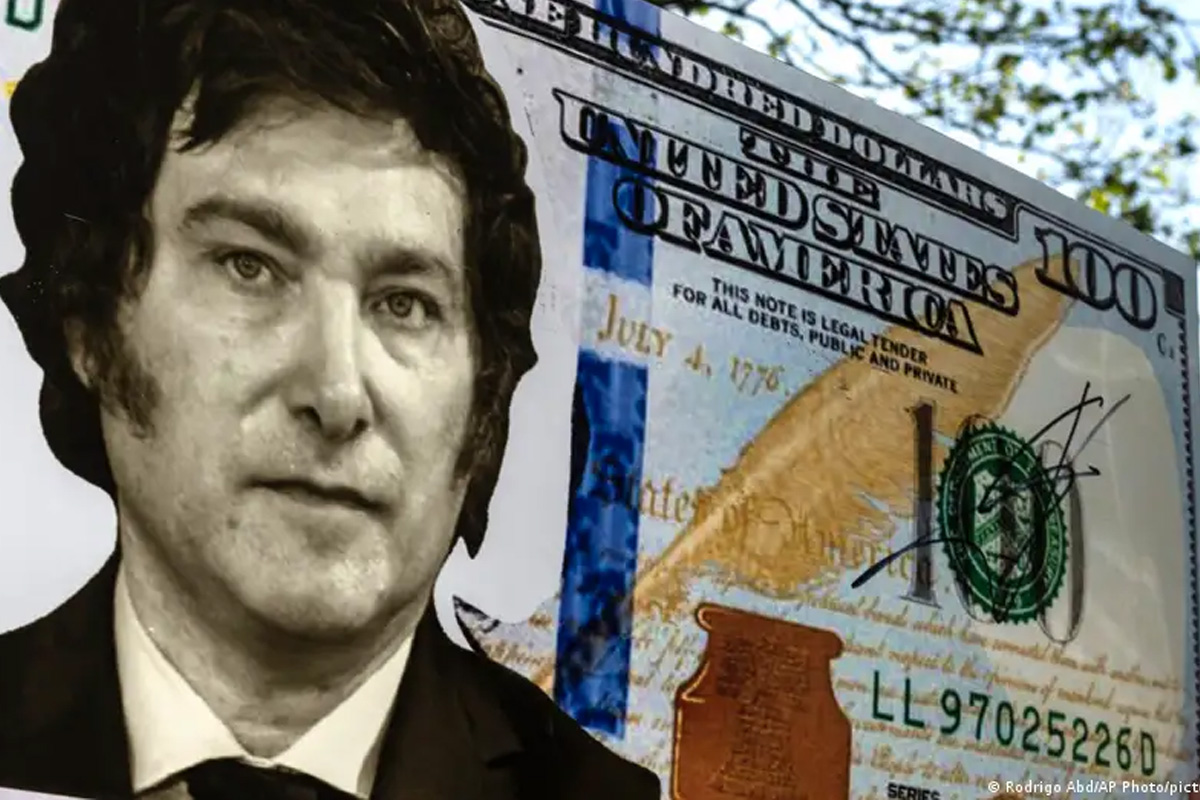President-elect Javier Milei, a self-described “anarcho-capitalist,” has radical ideas to prop up the ailing economy, including the introduction of the US dollar. Will that work?
Argentina’s new right-wing populist president-elect Javier Milei has never hidden his true intentions. On the election campaign trail, he brandished an oversized $100 bill with a montage of himself on it.
On camera, the 53-year-old chopped up a cardboard image of the central bank. His message was clear: Argentina needs the US dollar. And its own currency, the peso, must go, as must the central bank.
The assumption among observers is that Milei will struggle to follow up his extreme views with action for the time being, not least because he and his party, Freedom Advances, lack a parliamentary majority.
Nonetheless, his radical economic plans struck a nerve during the election campaign. The country’s economy is in turmoil and prospects a recovery look bleak.
Inflation in South America’s second-largest economy is rampant at more than 140%. Drought has severely affected harvests, while meat, fish and soy remain the country’s most important exports. As a result, the poor are getting even poorer, and the economy is expected to shrink further this year while public discontent is growing.
The US dollar as a quick-fix solution?
If Milei has his way, swapping out the peso for the US dollar will put Argentina back on track, as it did for other countries in the region, such as Ecuador and El Salvador. The two countries have accepted the dollar as a valid means of payment since 2000 and 2001, respectively. In Panama, the dollar has been the main means of payment since 1904.
Using the US currency as legal tender means that a fixed exchange rate determines the rate at which the existing currency is converted into dollars. The country’s own currency remains in circulation, but is usually no longer printed and gradually phased out.
The introduction of the US dollar in Ecuador and El Salvador brought down the inflation rate and stabilized their economies. On the flip side, however, both countries have had to take on more debt, pushing national debt up even further.
What are the advantages of dollarization?
According to Milei, Argentina’s economic malaise is the result of the wrong economic, fiscal and monetary policies. The president-elect and other proponents of dollarization are convinced that if you take control of the currency away from politicians (whom they call the elites and who are perceived as corrupt), the problems, notably inflation, will disappear.
“Argentina has always had high inflation,” says Nils Sonnenberg, an economic researcher at the Kiel Institute for the World Economy. “Since the introduction of the peso in 1881, there have been five currency reforms in which 13 zeros were removed from the banknotes. And there have been two hyperinflations [even] without war.”
It’s no surprise that the public’s trust in politics and the stability of the peso is low. Those who can keep their money in currencies that are considered more stable.
At the end of 2022, Argentinians held more than $246 billion (€225 billion) in foreign accounts or as dollar bills — around half of the country’s annual economic output, according to the country’s National Institute of Statistics. Argentinians have found a way to get around capital controls, in place since 2019, designed to make the flight into foreign currencies more difficult.
The country’s central bank is also in the spotlight. It’s largely been unable to ensure a stable currency due to its lack of political independence. In Argentina, the central bank is subordinate to the Economy Ministry. In the past, the government has dismissed central bank chiefs, secured access to reserves and encouraged the bank to print money.
“In the last 122 years — that is, since 1900 — Argentina has had a budget deficit, i.e., higher expenditure than income,” says Sonnenberg.
“You have to cover a deficit like that somehow — either through higher taxes or higher debt. And if you can’t run up any more debt, then you print money,” he says.
Proponents of dollarization say that using the US dollar as the national currency would provide Argentinian companies and households with more stability and operability.
The dangers of dollarization
While dollarization can have certain advantages, there’s also a downside. If politicians have no control over the currency, the scope for policies shrinks substantially.
In the absence of a local currency, the financial constraints on subsidies, social programs, the education sector or fulfilling election pledges become a growing impediment.
Equally, recessions and economic crises would become more painful than they already are if the state has no means to mitigate the greatest hardships.
It would also be impossible to gain a competitive advantage by devaluing one’s own currency, be it for domestic exporters or the tourism sector.
Argentina has previous experience with that problem. Between 1991 and 2001, the country pegged its currency to the US dollar by law at a rate of 1:1. When crucial trading partners such as Brazil and Mexico devalued their currencies sharply against the dollar at the end of the 1990s, the Argentinian economy suffered. Its goods became too expensive, and buyers turned their backs. As a result, Argentina had to abandon the 1:1 exchange rate.
If or when the dollar is introduced, it carries with it both the promise of stability and an economic risk for Argentina. The only certainty is that the president-elect will have to make compromises in the absence a political majority.
Notwithstanding its support for Milei in the run-off election, the opposition Republican Proposal party is pursuing a more moderate reform course than the president-elect, says IfW expert Sonnenberg: “I think he will have to adapt to these political realities.”







